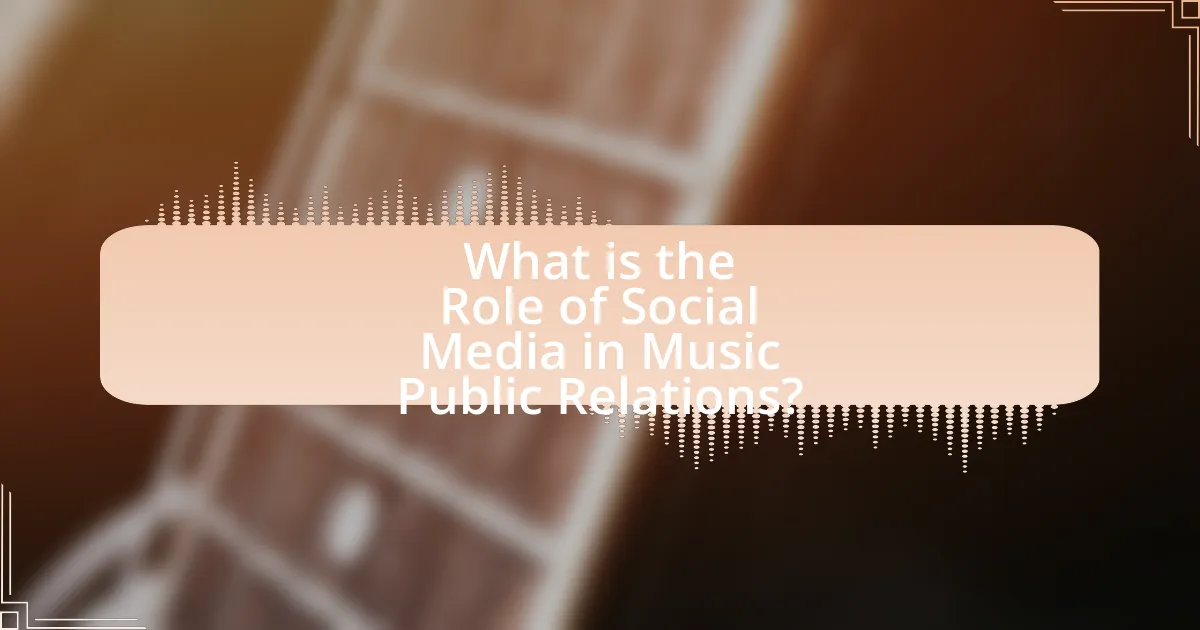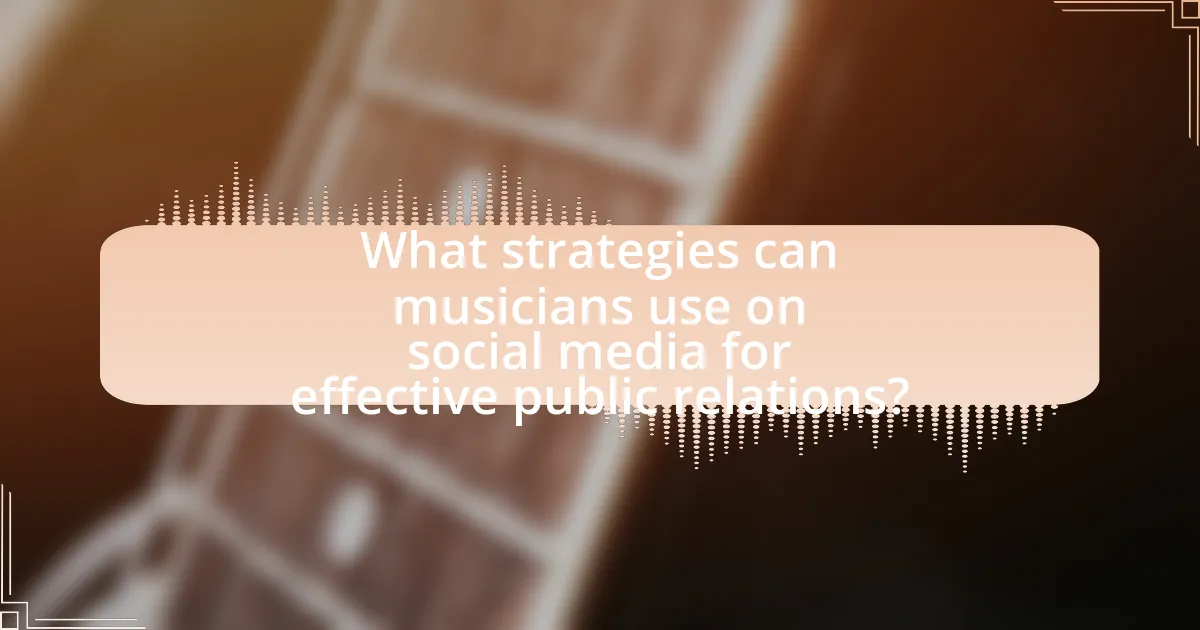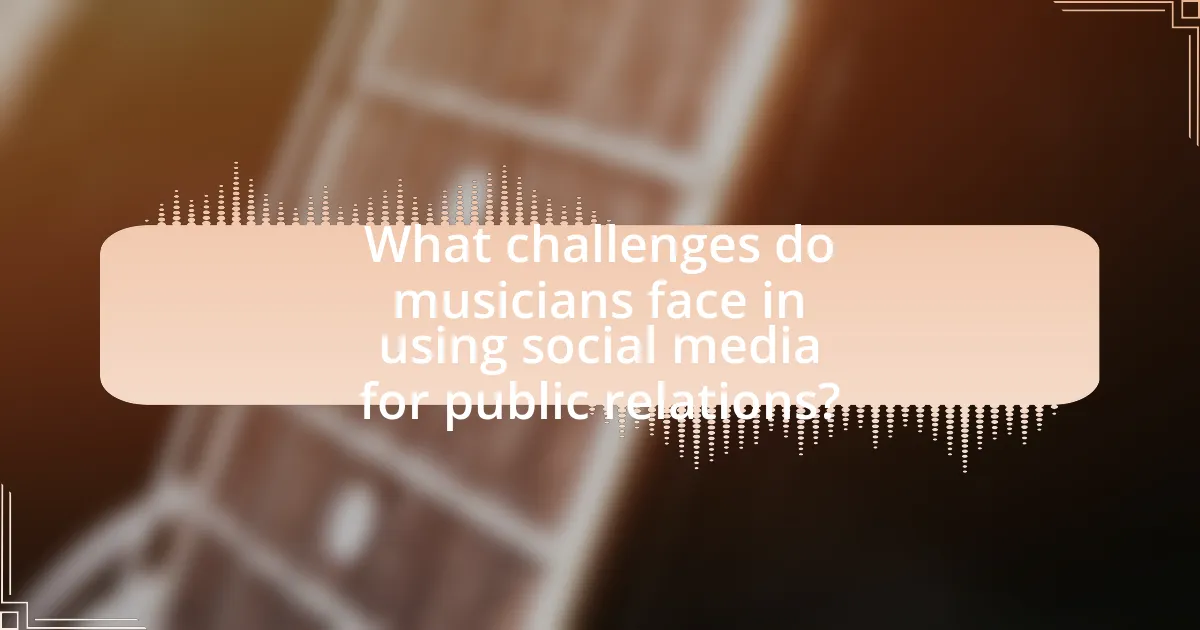The article examines the critical role of social media in music public relations, highlighting its function as a direct communication channel between artists and their audiences. It discusses how platforms like Instagram, Twitter, and TikTok have transformed engagement strategies, allowing musicians to promote their work, connect with fans, and build their brands without relying solely on traditional media. Key topics include the advantages of social media over traditional media, effective strategies for audience engagement, the impact of influencers, and the challenges musicians face in managing their online presence. The article also emphasizes the importance of analytics in optimizing social media efforts for better public relations outcomes.

What is the Role of Social Media in Music Public Relations?
Social media plays a crucial role in music public relations by facilitating direct communication between artists and their audiences. This platform allows musicians to share updates, promote new releases, and engage with fans in real-time, enhancing their visibility and brand presence. According to a 2021 survey by the International Federation of the Phonographic Industry, 83% of music consumers use social media to discover new music, highlighting its effectiveness as a promotional tool. Additionally, social media enables targeted marketing campaigns, allowing artists to reach specific demographics and build a loyal fan base.
How has social media transformed music public relations?
Social media has transformed music public relations by enabling direct communication between artists and their audiences, significantly enhancing engagement and reach. Platforms like Instagram, Twitter, and TikTok allow musicians to share updates, promote new releases, and interact with fans in real-time, which fosters a more personal connection. According to a 2021 report by the International Federation of the Phonographic Industry, 70% of music consumers engage with artists on social media, illustrating its critical role in shaping public perception and marketing strategies. This shift has led to a more democratized landscape where traditional media gatekeepers are less influential, allowing independent artists to gain visibility and build their brands without relying solely on record labels or publicists.
What are the key platforms influencing music public relations?
The key platforms influencing music public relations include social media networks such as Instagram, Twitter, Facebook, and TikTok. These platforms enable artists and music professionals to engage directly with fans, share content, and promote releases effectively. For instance, TikTok has become a significant driver of music trends, with viral challenges leading to increased streams and visibility for songs. According to a report by the Recording Industry Association of America, social media engagement has been linked to higher sales and streaming numbers, demonstrating the platforms’ impact on music public relations strategies.
How do artists utilize social media for public relations?
Artists utilize social media for public relations by engaging directly with their audience, promoting their work, and managing their public image. Through platforms like Instagram, Twitter, and Facebook, artists can share updates about new releases, upcoming events, and personal insights, fostering a sense of connection with fans. For instance, a study by the Pew Research Center found that 72% of adults use social media, making it an effective tool for artists to reach a broad audience. Additionally, artists can respond to fan inquiries and feedback in real-time, which enhances their relatability and strengthens their brand. This direct interaction not only builds loyalty but also allows artists to control their narrative and address any public relations issues promptly.
Why is social media essential for music promotion?
Social media is essential for music promotion because it provides artists with direct access to a global audience, enabling them to share their music and engage with fans instantly. Platforms like Instagram, Twitter, and TikTok allow musicians to showcase their work, build a personal brand, and create a community around their music. According to a 2021 report by the International Federation of the Phonographic Industry, 75% of music consumers discover new music through social media, highlighting its critical role in reaching potential listeners. Additionally, social media facilitates real-time interaction, allowing artists to receive immediate feedback and adapt their marketing strategies accordingly, further enhancing their promotional efforts.
What advantages does social media offer over traditional media?
Social media offers several advantages over traditional media, including real-time engagement, targeted audience reach, and cost-effectiveness. Unlike traditional media, which often involves lengthy processes for content creation and distribution, social media allows for immediate interaction and feedback between artists and their audience. This immediacy fosters a more dynamic relationship, enabling artists to respond to fan inquiries and trends swiftly. Additionally, social media platforms provide tools for precise audience targeting, allowing musicians to tailor their messages to specific demographics, which enhances the effectiveness of their promotional efforts. Furthermore, the cost of advertising on social media is generally lower than that of traditional media outlets, making it accessible for independent artists and smaller labels to promote their work without significant financial investment.
How does social media enhance audience engagement for musicians?
Social media enhances audience engagement for musicians by providing direct communication channels that facilitate interaction and community building. Musicians can share content such as updates, behind-the-scenes footage, and live performances, which fosters a sense of connection with fans. According to a study by the Pew Research Center, 72% of adults use social media, allowing musicians to reach a broad audience and engage with them in real-time. This immediate feedback loop encourages fan participation through comments, shares, and likes, further strengthening the relationship between musicians and their audience.

What strategies can musicians use on social media for effective public relations?
Musicians can use targeted content creation, audience engagement, and strategic partnerships on social media for effective public relations. Targeted content creation involves sharing high-quality visuals, behind-the-scenes footage, and personal stories that resonate with fans, which can increase engagement and foster a loyal following. Audience engagement is crucial; musicians should actively respond to comments, host live Q&A sessions, and create polls to involve their audience in decision-making, thereby enhancing community feeling. Strategic partnerships with influencers or brands can amplify reach; for instance, collaborations with popular social media figures can introduce musicians to new audiences, as evidenced by the success of artists like Lil Nas X, who leveraged TikTok to gain viral popularity. These strategies collectively enhance visibility and strengthen the musician’s brand in the competitive music industry.
How can musicians create a strong online presence?
Musicians can create a strong online presence by consistently engaging with their audience through social media platforms, sharing high-quality content, and utilizing targeted marketing strategies. Engaging with fans through regular posts, live streams, and interactive content fosters a sense of community and loyalty. High-quality content, including professional music videos, behind-the-scenes footage, and personal stories, enhances visibility and relatability. Targeted marketing strategies, such as using analytics to understand audience demographics and preferences, allow musicians to tailor their outreach effectively. According to a 2021 survey by the International Federation of the Phonographic Industry, 80% of music consumers discover new music through social media, highlighting its critical role in building an online presence.
What types of content resonate most with music audiences?
Music audiences resonate most with authentic and engaging content, such as behind-the-scenes footage, live performances, and personal stories from artists. This type of content fosters a deeper connection between the artist and the audience, as it provides insights into the creative process and personal experiences. Research indicates that 70% of music fans prefer content that showcases the artist’s personality and lifestyle, enhancing relatability and emotional engagement. Additionally, interactive content like polls, Q&A sessions, and fan challenges significantly boosts audience participation and loyalty, as evidenced by platforms like Instagram and TikTok, where user engagement metrics are notably higher for such formats.
How often should musicians post on social media for maximum impact?
Musicians should post on social media at least 3 to 5 times per week for maximum impact. This frequency helps maintain audience engagement and visibility in a crowded digital space. Research indicates that consistent posting can lead to higher interaction rates; for instance, a study by HubSpot found that brands posting 16 times per month saw 3.5 times more engagement than those posting less frequently. Therefore, musicians can optimize their social media strategy by adhering to this posting frequency to effectively connect with their audience and enhance their public relations efforts.
What role do influencers play in music public relations on social media?
Influencers play a crucial role in music public relations on social media by amplifying artists’ reach and engagement with their target audience. They leverage their established follower base to promote music releases, events, and brand partnerships, effectively acting as intermediaries between artists and fans. For instance, a study by the Digital Marketing Institute found that 49% of consumers depend on influencer recommendations when making purchase decisions, highlighting the significant impact influencers have on audience behavior. Additionally, influencers can create authentic content that resonates with their followers, fostering a sense of community and loyalty around the artist. This dynamic not only enhances visibility but also drives streaming numbers and ticket sales, making influencers an integral part of modern music marketing strategies.
How can musicians collaborate with influencers effectively?
Musicians can collaborate with influencers effectively by identifying influencers whose audience aligns with their target demographic and creating authentic content that resonates with both parties. This alignment ensures that the collaboration feels genuine, increasing engagement and reach. For instance, a study by the Digital Marketing Institute found that 49% of consumers depend on influencer recommendations, highlighting the potential impact of such partnerships. Additionally, musicians should leverage platforms like Instagram and TikTok, where influencers often have a strong presence, to showcase their music through challenges, live sessions, or behind-the-scenes content, further enhancing visibility and connection with fans.
What are the potential risks of influencer partnerships?
The potential risks of influencer partnerships include reputational damage, lack of authenticity, and regulatory compliance issues. Reputational damage can occur if an influencer engages in controversial behavior or makes statements that conflict with the brand’s values, leading to negative public perception. Lack of authenticity arises when influencers promote products they do not genuinely use or believe in, which can alienate their audience and diminish trust. Regulatory compliance issues may arise from failing to disclose paid partnerships, which can result in legal penalties and damage to both the influencer’s and the brand’s credibility. According to a study by the Federal Trade Commission, non-disclosure of paid endorsements can lead to significant fines, highlighting the importance of transparency in influencer marketing.

What challenges do musicians face in using social media for public relations?
Musicians face several challenges in using social media for public relations, including oversaturation of content, algorithm changes, and audience engagement. The oversaturation of content makes it difficult for individual musicians to stand out, as millions of posts compete for attention daily. Additionally, frequent changes in social media algorithms can limit the visibility of musicians’ posts, making it harder for them to reach their target audience effectively. Furthermore, engaging with followers consistently requires time and effort, which can be challenging for musicians who are also focused on their creative work. These factors collectively hinder musicians’ ability to leverage social media effectively for public relations.
How can negative feedback on social media impact musicians?
Negative feedback on social media can significantly impact musicians by affecting their mental health, public image, and career opportunities. Musicians often experience emotional distress due to harsh criticism, which can lead to anxiety and depression; studies indicate that 60% of artists report mental health issues linked to social media interactions. Additionally, negative comments can tarnish a musician’s reputation, leading to decreased fan engagement and loss of potential collaborations. For instance, a survey by the Music Industry Research Association found that 70% of musicians believe that negative online feedback can deter promoters and venues from booking them. Thus, the repercussions of negative feedback on social media are profound, influencing both personal well-being and professional success in the music industry.
What strategies can musicians employ to manage criticism online?
Musicians can manage criticism online by actively engaging with their audience, maintaining a positive online presence, and utilizing feedback constructively. Engaging with fans through direct responses can foster a sense of community and demonstrate that the musician values their opinions. Maintaining a positive online presence involves sharing uplifting content and showcasing achievements, which can help mitigate negative comments. Additionally, utilizing feedback constructively allows musicians to identify areas for improvement while demonstrating resilience and adaptability. Research indicates that artists who engage positively with criticism can enhance their reputation and strengthen their fan base, as seen in studies on social media interactions in the music industry.
How can musicians protect their brand from misinformation on social media?
Musicians can protect their brand from misinformation on social media by actively monitoring their online presence and promptly addressing false claims. Regularly searching for mentions of their name and music allows musicians to identify and counteract misinformation quickly. For instance, a study by the Pew Research Center found that 64% of Americans believe misinformation is a major problem, highlighting the importance of vigilance. Additionally, musicians should engage with their audience through official channels, providing accurate information and clarifying any misconceptions. This proactive approach not only helps in correcting false narratives but also builds trust with fans, reinforcing their brand integrity.
What are the best practices for musicians in social media public relations?
The best practices for musicians in social media public relations include consistent engagement with fans, authentic content creation, and strategic use of analytics. Musicians should regularly interact with their audience through comments, live sessions, and direct messages to build a loyal community. Authentic content, such as behind-the-scenes footage and personal stories, fosters a genuine connection and enhances relatability. Additionally, utilizing analytics tools helps musicians understand audience preferences and optimize their content strategy, leading to increased reach and engagement. Research indicates that musicians who actively engage with their audience on social media see a 30% increase in fan loyalty and a 25% boost in concert attendance.
How can musicians measure the success of their social media efforts?
Musicians can measure the success of their social media efforts by analyzing key performance indicators (KPIs) such as engagement rates, follower growth, and conversion metrics. Engagement rates, which include likes, shares, and comments, indicate how well the audience interacts with the content, while follower growth reflects the expanding reach of the musician’s brand. Conversion metrics, such as the number of streams, downloads, or ticket sales generated from social media campaigns, provide concrete evidence of the effectiveness of these efforts. According to a 2021 report by Hootsuite, posts with higher engagement rates can lead to a 10% increase in overall audience reach, demonstrating the importance of these metrics in assessing social media success.
What tools can assist musicians in managing their social media presence?
Musicians can utilize tools such as Hootsuite, Buffer, and Sprout Social to effectively manage their social media presence. Hootsuite allows users to schedule posts across multiple platforms, track engagement metrics, and monitor brand mentions, making it easier for musicians to maintain a consistent online presence. Buffer offers similar scheduling capabilities and provides analytics to help musicians understand their audience’s preferences and optimize content accordingly. Sprout Social enhances these functionalities with advanced reporting features and social listening tools, enabling musicians to engage with their fans more effectively. These tools are widely recognized in the industry for their ability to streamline social media management and improve audience interaction.
How can musicians leverage social media analytics for better public relations?
Musicians can leverage social media analytics to enhance public relations by analyzing audience engagement metrics to tailor their content and communication strategies. By examining data such as likes, shares, comments, and follower demographics, musicians can identify which types of posts resonate most with their audience, allowing them to create more targeted and effective messaging. For instance, a study by Sprout Social found that posts with images receive 650% more engagement than text-only posts, highlighting the importance of visual content in capturing audience attention. Additionally, tracking sentiment analysis can help musicians understand public perception and adjust their public relations strategies accordingly, ensuring they maintain a positive image and foster stronger connections with fans.
What key metrics should musicians focus on for effective analysis?
Musicians should focus on engagement rate, follower growth, reach, and conversion rate for effective analysis. Engagement rate measures the interaction level of followers with content, indicating how well the audience connects with the music. Follower growth tracks the increase in audience size over time, reflecting the effectiveness of promotional strategies. Reach assesses how many unique users see the content, which is crucial for understanding visibility. Conversion rate evaluates the percentage of followers taking desired actions, such as streaming music or purchasing merchandise, demonstrating the impact of social media efforts on sales. These metrics provide a comprehensive view of a musician’s online presence and effectiveness in engaging their audience.
How can data-driven decisions improve social media strategies?
Data-driven decisions can significantly enhance social media strategies by enabling targeted content creation and audience engagement. By analyzing metrics such as engagement rates, demographic data, and user behavior, organizations can tailor their messaging to resonate with specific audience segments. For instance, a study by HubSpot found that companies using data analytics in their marketing strategies saw a 20% increase in engagement rates. This evidence demonstrates that leveraging data allows for more effective allocation of resources and optimization of content, ultimately leading to improved performance in social media campaigns.